If you have a VMDK file that hosts one or more VM partitions, here are 4 ways to get it mounted in Windows as a disk drive.
Windows Explorer
Supporting VMDK seems to be a feature built right into the Windows system. If you are using a system that runs Windows 7 or above, you may be able to map the image file right through Windows Explorer.
Navigate to the fold that hosts VMDK file in Windows Explorer, right-click the file and choose Map Virtual Disk.

Select the drive letter you want to map to, and click OK button on the Map Virtual Disk window.

To disconnect, right-click the mapped drive and choose Disconnect Virtual Disk.
It works beautifully when it works. When it’s not, it’s time to seek alternative options.
VMware Workstation
VMware Workstation is VMware’s desktop solution for virtualization. It has the “Map Virtual Disks” feature built in that opens VMDK in a wider format. If the method of using Windows Explorer doesn’t work out, VMware Workstation is next one in the line to try.
Go to File menu and select Map Virtual Disks… from the drop-down list to start the process.
vSphere Disk Development Kit
The “VMware-mount” command line is the one you can use to mount a VMDK disk without a GUI interface. The tool is part of the vSphere Disk Development Kit, so you need to download and install the kit to use the tool.
To mount a VMDK file (saved at C:\temp) in read-only mode use the following command:
vmware-mount.exe X: “C:\Temp\TestVM.vmdk”
If the VMDK file contains more than one partition you can use the parameter /v:x to mount the other volumes:
vmware-mount.exe /v:2 X: “C:\Temp\TestVM.vmdk”
If you need a writeable access, just use the parameter “/m:w“. This is extremely helpful if you need to replace a broken system file.
vmware-mount.exe /m:w X: “C:\Temp\TestVM.vmdk”
If you want to list all the mounted virtual drives use /L:
vmware-mount.exe /L
The command line is easy to use and powerful, but I am finding it’s not so easy to get the Development Kit installed on my computer for some reason.
OSFMount
OSFMount is a 3rd party free image mounting tool that mounts not only ISO format images but also VMDK files in Windows with a drive letter. It works on pretty much all versions of Windows.

It’s fairly easy to use the tool. Click the Mount new… button at the bottom of the window and follow the instructions.
If you have other alternative options, feel free to share. It’s never enough to have a reliable tool that does the job well in hand.
/Update on July 8, 2020/
As some of the commenters pointed out, the open-source archiving tool 7-Zip does happen to be the easiest way to open the VMDK file for you. By all means, give 7-Zip a try first and if it failed, try something mentioned above.
For some reason, you may need to open a VMDK file to read or transfer the content without using it on a virtual machine. In this guide let me show the simple and easy method to open a VMware VMDK file in Windows 10/11, the same method is applicable for earlier Windows Operating Systems such as 8.1 and 7 as long as you have any VMware products on your computer.
Also, we can access the Physical hard disk (like C or D partition of the host computer) inside Virtual Machine by this method in VMware. But, in this guide, we will discuss how to access the VMDK virtual disk file in Windows OS without powering on the particular VM. This method could be an ideal solution when you have a Virtual machine that is not booting, but you need to access some important data from the specific virtual hard disk file.
1) Locate the virtual disk file you want to open or edit in Windows host OS. Right-click on it as shown below.

2) You must have a VMware workstation (or VMware Player) on the host computer to make it work.
Most of the time the VMDK file type would have been already associated with the VMware program. Once your Windows host computer knows that VMDK files should be opened by the VMware Workstation program, you will see an option called “Map Virtual Disk..” as shown above.
If you notice, there is another option below called “Map First Volume as Z:”, it will automatically mount and open the first volume of the VMDK file in read-only format. But we are not aware of what is the first volume and mostly it could be the system reserved portion on the bootable partition, hence it will not be helpful. So, select the first option “Map Virtual Disk..” and explore all partitions. Later we can select the desired partition to mount as shown in the next step.
3) It is always recommended to open the VMDK files in Read-only format to prevent any modifications to the virtual disk file that may cause booting or operating system issues for the virtual machine. If you are certain of what you are doing, then you can remove the tick and open the drive with writing access.
This method will help to modify some boot options, overwrite corrupted files and do any other tasks to troubleshoot issues on the virtual machine. Once the ‘Map Virtual Disk’ option is opened, select the partition you want to open on the host computer, change the Read-only access (required) and the mount point drive letter.
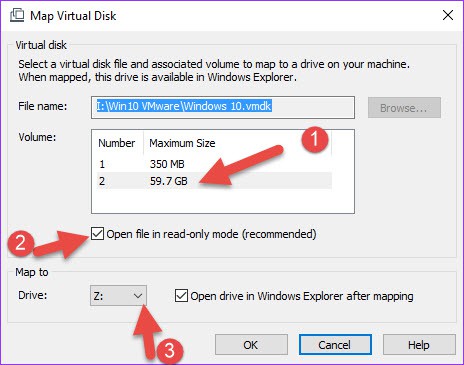
In the above example, I selected the 2nd partition (which is the C drive of the Virtual machine) with read-only access. Z is the drive letter of the mount point on my Windows 10 host.
4) Here is the VMDK file mounted on Windows explorer with the specific drive letter.
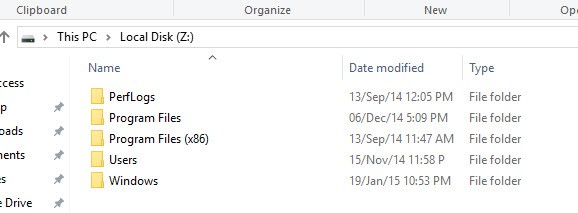
5) Now I can easily copy the data from the virtual hard disk (VMDK) to host Windows 10 or 8.1/1 through Windows Explorer. Since I opened it in Read-only access, I can’t delete or modify any files inside the VMDK file.
Remember This Step:
Do remember to unmount (Disconnect) the file once your task is completed. Otherwise, you can’t use the VMDK file in VMware programs or move the file to a different location because it will be in locked/open state.

I hope this guide is useful in opening the VMware VMDK file in Windows 10, 8.1 and 11 easily. Though there are several 3rd party tools available to mount or extract the VMDK files, they are complicated and paid versions too. This method can be done without any tools if you have a VMware workstation on your computer.
Download Windows Speedup Tool to fix errors and make PC run faster
VMDK, VHDX, and VHD are file formats of Virtual drives. They are unique and unlike other files, you can not just double-click on them to open the file. This is a complete guide on how to open VMDK, VHDX, VHD files in Windows 11/10.
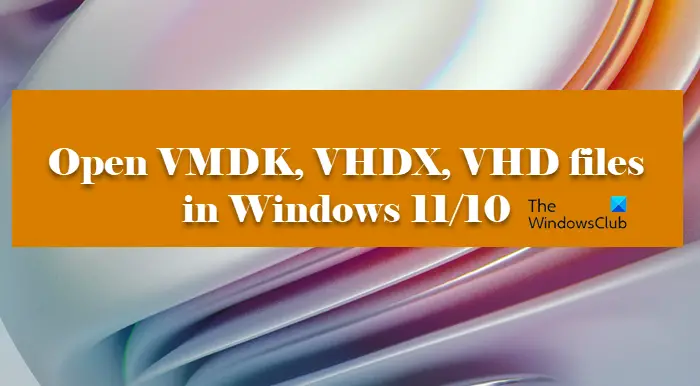
What are VMDK, VHDX, and VHD files?
- VHD or Virtual Hard Disk is a file format that is used to represent Virtual Drives. It is similar to the hard drive present on your system as it contains all the data and structural elements. It acts like a disk that you can easily access from File Explorer but will be stored on a physical hard drive.
- VHDX or Virtual Hard Disk v2 is an advanced version of Virtual Hard Disk. The major difference between the two formats is that, unlike VHD, these files can hold more than 2040 GB, as their limit is 64 TB. However, VHDX is not supported on all the versions of Windows, you need to have Windows 8 or above to use this file format.
- VMDK or Virtual Machine Disk was created by VMWare for Virtual Machines. However, they can be used on Oracle VirtualBox, VMWare, and other virtualization software. As the name implies, they are used in a virtual environment.
VHD and VHDX are used interchangeably, but one is more advanced than the other, VMDK on the other hand is different from the two.
Mount and/or Open VMDK, VHDX, VHD files in Windows 11/10
Now that you know what these files are, we are going to see how to open VMDK, VHDX, VHD files on your computer.
Open VHD or VHDX files in Windows
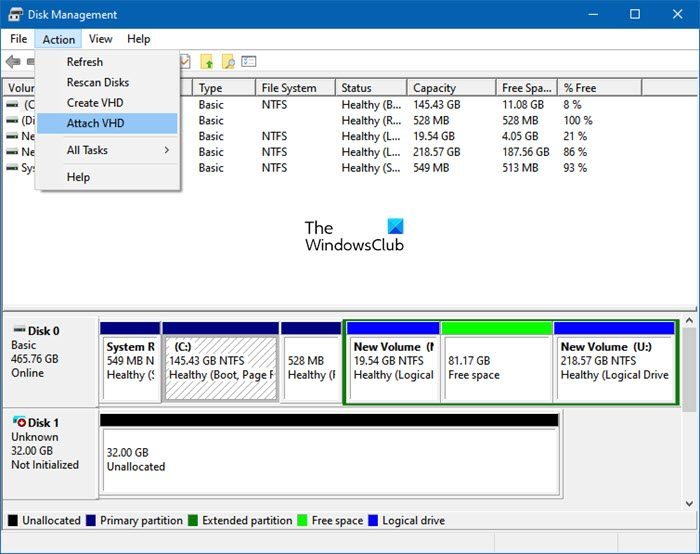
The method to open VHD and VHDX files are the same, but to check VMDK, you need to use a different procedure. To open Virtual Hard Drive files, you first need to mount and then open them, follow the given steps to do the same.
- Open Disk Management by searching from the Start Menu or by Win + X > Disk Management.
- Click Action > Attach VHD.
- Click Browse and search out VHD or VHDX file.
- Once you open the files, a new drive will be created.
- You will be able to see that newly created drive under This PC > Devices and drives.
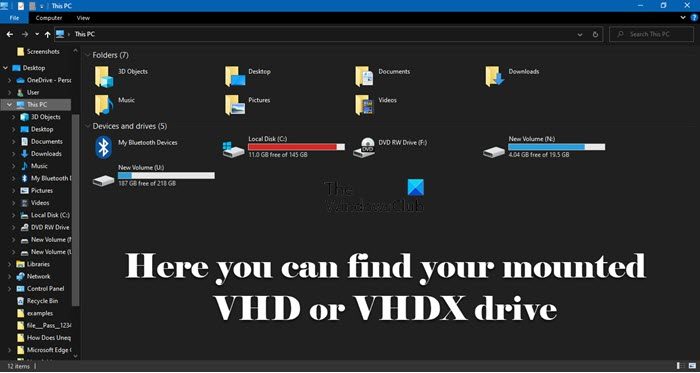
Read: How to create and set up new VHD or VHDX File in Windows
Open VMDK files in Windows
Now, we need to open VMDK aka Virtual Machine Disk file. There are various methods to do the same, it can be opened with almost any Virtual Machine software. In this guide, we are going to see how to do VMDK on the following machines.
- Oracle VirtualBox
- VMWare Workstation
Let us hop into it.
1] Oracle VirtualBox
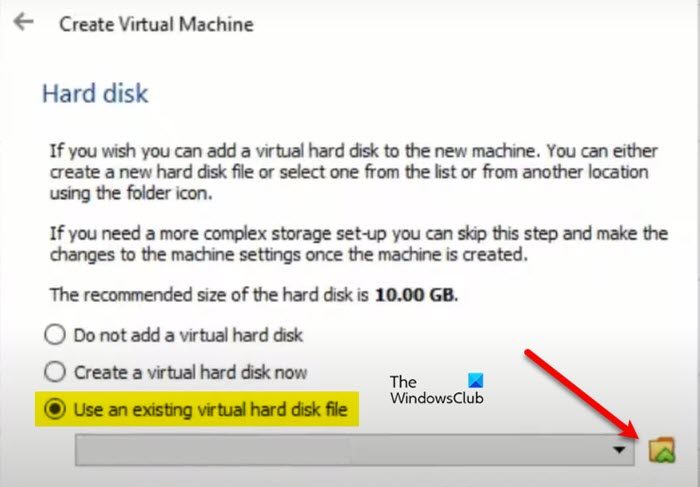
VMDK format was introduced by VMWare but it works on pretty much all the VM software. First up, we are going to see how to do the same on VirtualBox. Follow the given steps to open the Virtual Machine Disk file on VirtualBox.
- Open VirtualBox.
- Click on New.
- Give it, set the platform, select where you want the machine to be stored and click Next.
- Now, select Use an existing virtual hard disk file and click on the Browse button.
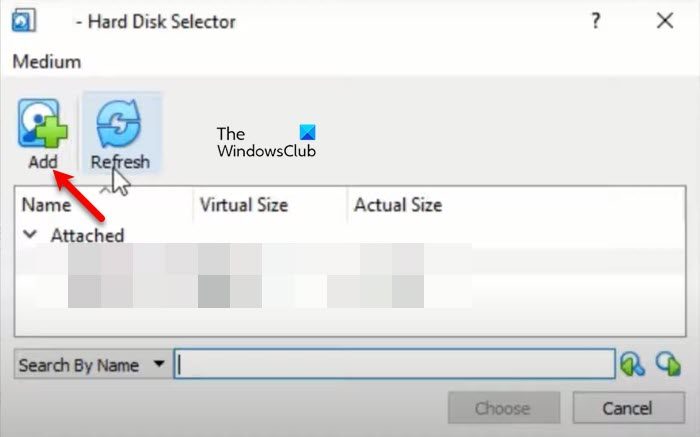
- Click Add.
- Go to the location where you have stored the file and open it.
- Select the file again in Hard Disk Selector and click Choose.
- Click Create > Start.
Hopefully, this will work for you.
2] VMWare Workstation
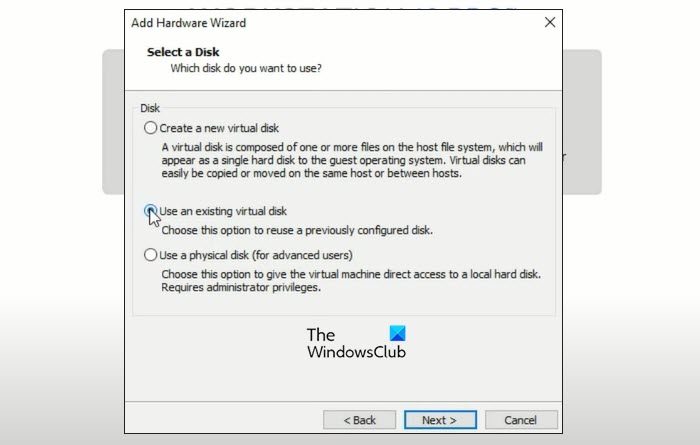
To open VMWare Workstation, follow the given steps.
- Open the app.
- Follow the normal procedure to create a virtual machine, that is, by following the on-screen instruction.
- Once you have created the machine, and are on the OS installation page, click on Edit virtual machine setting.
- Select your Hard Disk and click Remove.
- Click Add > Hard Disk > Next > SCSI > Next.
- Select the Use an existing virtual disk option and click Next.
- Click Browse, go to the location where you have stored the file and open it.
- Now, click Power on the virtual machine.
That’s it!
Read: How to convert VHD to VHDX using Hyper-V Manager
How do I mount a VHDX file in Windows 11?
VHDX files can be easily mounted using the Disk Management utility. It is a pre-installed Windows program used to maintain the drives of a system. From here you can not only mount or demount your VHDX and VHD files but can also take care of other disks as well. You can merge, extend, or shrink any drive other than the one on which your OS is installed.
Read: Best free ISO Mounter software for Windows.
Yusuf is an Engineering graduate from Delhi. He has written over 1000 technical articles and has knowledge of programming languages including Java, and C++, and technologies such as Oracle 12C and MsSQL. Troubleshooting Windows is his favorite past-time.
Reader Interactions
Если у вас есть файл VMDK (Virtual Machine Disk), который содержит один или несколько разделов виртуальной машины VMware, вы можете смонтировать его в операционной системе Windows в качестве диска. Подключить vmdk диск в Window можно несколькими способами.
- Подключение vmdk файла в проводнике Windows Explorer
- Подключение образа VMDK в VMware Workstation
- Монтирование VMDK с помощью пакета vSphere Disk Development Kit
- Используем OSFMount для монтирования vmdk
Содержание:
Подключение vmdk файла в проводнике Windows Explorer
В операционной система Windows имеется встроенная поддержка VMDK файлов. Если вы используете операционную систему Windows 7 или выше, вы можете смонтировать файл VMDK прямо через проводник Windows.
Для этого нужно перейти в каталог, в котором хранится файл VMDK. В проводнике Windows щелкните по файлу правой кнопкой мыши и выберите пункт «Map Virtual Disk».
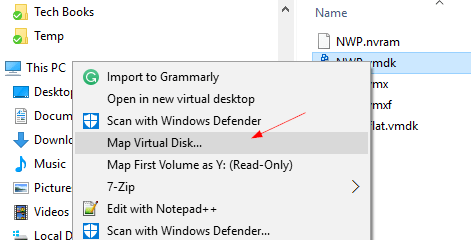
В окне «Map Virtual Disk» выберите букву, которая будет присвоена диску и нажмите кнопку «ОК».
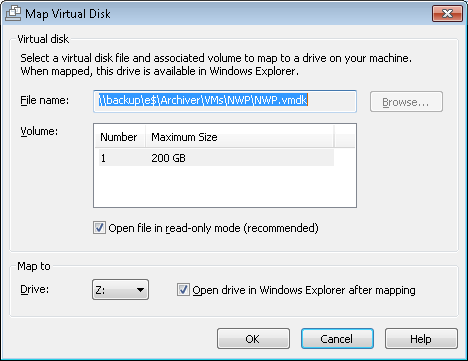
Для того, чтобы отключить виртуальный диск — щелкните правой кнопкой мыши по диску и выберите пункт «Disconnect Virtual Disk».
Подключение образа VMDK в VMware Workstation
VMware Workstation – это настольное ПО для виртуализации от VMware. В нем имеется встроенная функция подключения vmdk образов — «Map Virtual Disks», с помощью которой также можно смонтировать и открыть файл VMDK. Если открыть файл VMDK при помощи первого описанного нами способа не получается (Проводник Windows), то при помощи VMware Workstation сделать это удастся наверняка.
Все довольно просто, перейдите в меню «File» и в раскрывающемся списке выберите пункт «Map Virtual Disks …».
Монтирование VMDK с помощью пакета vSphere Disk Development Kit
VMware-mount — это консольная утилита, которую вы можете использовать для монтирования VMDK дисков без использования графического интерфейса. Эта утилита входит в пакет разработчика vSphere Disk Development Kit, поэтому для её использования вам понадобиться его установить.
Чтобы смонтировать файл VMDK (сохраненный в каталоге C:\temp) в режиме только для чтения, используйте следующую команду:
vmware-mount.exe X: “C:\Temp\TestVM.vmdk”
Если файл VMDK содержит более одного раздела, вы можете использовать параметр /v:x для монтирования других томов:
vmware-mount.exe /v:2 X: “C:\Temp\TestVM.vmdk”
Если вам необходима возможность записи, воспользуйтесь параметром «/m:w». Этим можно воспользоваться, например — если вам нужно заменить испорченный системный файл.
vmware-mount.exe /m:w X: “C:\Temp\TestVM.vmdk”
Если вы хотите вывести все подключенные виртуальные диски, необходимо воспользоваться параметром /L:
vmware-mount.exe /L
Командной строкой очень легко пользоваться, при этом она довольно функциональна.
Используем OSFMount для монтирования vmdk
OSFMount – это бесплатная сторонняя утилита, которая монтирует файлы образов не только формата ISO, но также и файлы VMDK. Она работает практически во всех версиях Windows.
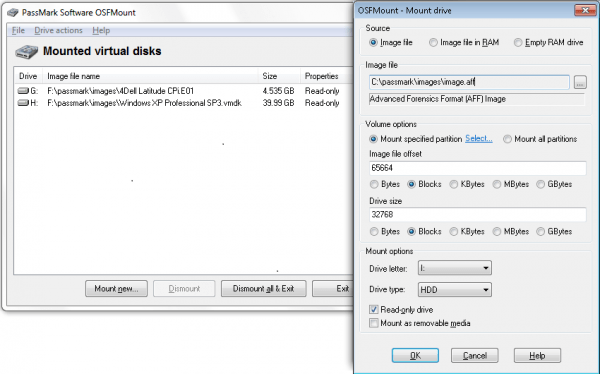
Эта утилита довольно проста в использовании. Достаточно нажать кнопку «Mount new…» расположенную в нижней части окна, выбрать vmdk файл и указать параметры подключения.
Virtual Machine Descriptor File (VMDK) is a file extension for virtual disk image files that are created by VMware products, such as VMware Workstation, VMware ESXi, and other third-party tools. It is frequently used for cloud computing services and virtualization. A virtual VMDK file carries all the information of a virtual machine. Normally, non-virtualized machines can only obtain individual system files and components, but a virtual disk file contains all the necessary information on a single disk, which empowers it for individualistic operations.
We attach VMDK with VMware as we use it to store one or more Virtual Files and it can only be accessed as a physical hard disk with VMware Software.
VMDK file is generally used by VMware software but we can mount VMDK in VMware as a virtual disk using Win Mount. As a result, users can easily delete, copy, and modify the files in Virtual disk.
If you import VMDK in Vmware then it will be more easy for you to handle the VMDK files. You can modify, delete, or copy VMDK data. Follow the steps to do so:
- Open Installed VMware and Click on “File,” then “New” and “Virtual Machine“.
- Click “Next” and choose “Custom” for your system type.
- If your VMDK file is from an earlier version of VMWare then select “Legacy“. Hit “New” if it is from the current version. Click “Next” to continue.
- Choose the Operating System you are installing from the list and then choose its version from the drop-down menu. If you do not know, Hit the radio button next to “Other.” Click “Next” to move forward.
- Enter a name for the virtual machine and then choose a folder to store it.
- Specify the number of processors you would like to use. This must match the number of processors on your computer. The default setting of “one” is the safest.
- Choose the amount of memory you would like to allocate to the operating system. Adjust the slider until it reaches the minimum requirements listed on the screen.
- Choose your network type and click “Next.”
- Now from the Select a Disk window choose “Use an existing virtual disk” and click “Next.”
- Select the VMDK file on your hard drive and click it. Press “Open” to select it.
- Click “Finish.”
Note: When you try to open VMDK file in Windows VMware, many times you don’t succeed. Because it may be possible that the VMDK fails to open in Windows or you might get an error like VMware is not opening with Windows. As may the file is not well or corrupt. So let’s find out how to solve corruption in VMDK files Vmware.
Read here: How to fix issues with your VM
Issues with VMDK file
However, it is noted that numerous times when users want to access their VMDK file data, the virtual machine often stops operating or doesn’t open the VMDK file. There can be two possibilities behind this difficulty, either the VM is not cooperative with your machine or the VMDK file is defective.
In most cases, it is found that the VMDK file gets corrupted or damaged and stops the VM machine from powering on. So, let’s find out how a VMDK file gets corrupted, and how we can open a corrupt VMDK file in Windows Vmware.
How VMDK Files Are Prone to Corruption?
There can be many reasons for VMDK corruption but we have mentioned the most possible ones here:
- Abrupt Power Failures or System Crashes
- Improper Shutdown of Virtual Machines
- Disk Space Issues
- Mismanagement of Snapshots
- Virus or Malware Attacks
Errors that occur in VM when a VMDK file is not well:
- “Unable to start. A file not found”
- “Unable to find the required file”.
- “The machine can not find the specified file”.
How to Open or Attach a Corrupt VMDK File in VMware?
So, if you are concerned about opening your corrupt VMDK files, then recline because there are solutions that can help you to easily view or open your VMDK data. One of the best ways to do this is by using suitable software. However, saying and doing is altogether a separate process. As there is ‘N’ number of tools available over the internet which term themselves as the best. But selecting one is a quite tough task. Trust me on that.
So if you take my recommendation, I would refer you to check this VMDK Recovery Software. This tool is one of the best possible tools to view and open VMDK files in VMware & Windows 11, 10, 8, 7, XP, and other versions. Plus the best part of this tool is that it provides users a free demo version which lets you evaluate the complete features that the software is providing.
Some Notable Features of the software:
- Effective recovery of maximum possible data from corrupt VMDK files.
- This tool is quite proficient in supporting VMDK files that are saved in Fixed or Dynamic disc types.
- It supports VMDK files which are FLAT, split & SPARSE event descriptors.
- Offers two different scanning modes i.e. Standard and advanced depending upon the level of corruption.
- Support both partition tables, i.e. (MBR) & (GPT).
- The custom settings option is authorized for selected volumes before recovery.
- Support file systems of all OS, such as FAT, FAT16, FAT32, FAT64, NTFS, HFS+, and EXTX.
Download Now
Conclusion
So I hope now you successfully understand how to open a VMDK file in Vmware if the file is error-free. But if the file is not well then you might face issues attaching or importing VMDK in VMware. So use the VMDK Repair tool to fix the errors and easily import VMDK in VMware.
